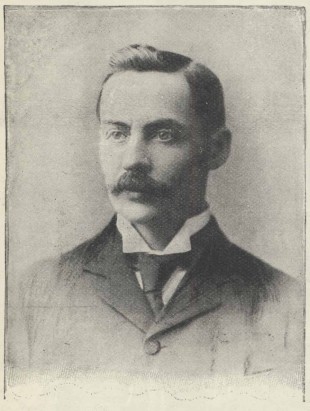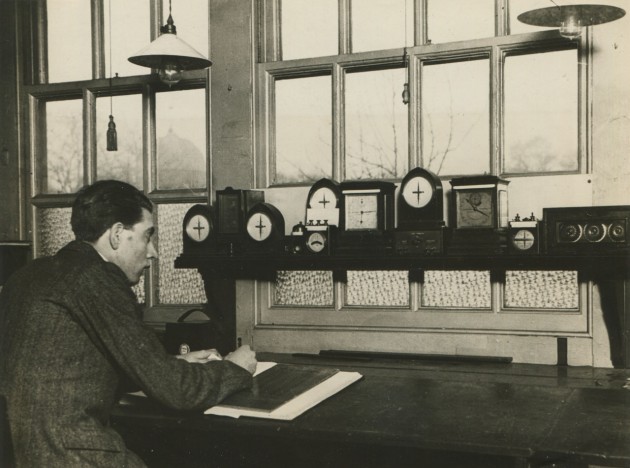…where east meets west
- Home
- Brief History
- The Greenwich Meridian
- Greenwich
(1675–1958) - Herstmonceux
(1948–1990) - Cambridge
(1990–1998) - Outstations (1822–1971)…
- – Chingford (1822–1924)
- – Deal
(1864–1927) - – Abinger
(1923–1957) - – Bristol & Bradford on Avon
(1939–1948) - – Bath
(1939–1949) - – Hartland
(1955–1967) - – Cape of Good Hope
(1959–1971)
- Administration…
- – Funding
- – Governance
- – Inventories
- – Pay
- – Regulations
- – Royal Warrants
- Contemporary Accounts
- People
- Publications
- Science
- Technology
- Telescopes
- Chronometers
- Clocks & Time
- Board of Longitude
- Libraries & Archives
- Visit
- Search
The staff of the Chronometer Department
The Observatory’s involvement with Chronometers dates back to 26 April 1766 when the Board of Longitude resolved that Harrison’s longitude watch (H4) along with his three earlier seagoing clocks should be tested there. Over the next 35 years, a small number of other chronometers were also tested for the Board.
A dramatic change took place in 1821 when the Astronomer Royal, John Pond, was made Superintendent of Chronometers for the use of His Majesty’s Navy. From that time onwards, chronometers took up vastly more of the Observatory’s time, with a dedicated Chronometer Department eventually being set up in the 1940s. In 1965, responsibility for the Department was transferred from the Astronomer Royal to the direct control of the Hydrographic Department of the Ministry of Defence as part of the transfer arrangements of the rest of the Observatory from the Admiralty to the Science Research Council.
Superintendent of Chronometers
One outcome of the 1818 Longitude Act was the creation of the post of Superintendent of Chronometers with an annual allowance of £100 a year. The first Superintendent was Thomas Hurd. He had nothing to do with the Observatory and was appointed in 1819. On 23 July 1821 (RGO5/229), the post was assigned to the Astronomer Royal, John Pond, who was paid the £100 allowance in addition to his existing salary. From that time onwards, the post was always held by the Astronomer Royal.
Following Pond’s retirement in 1835, the post was held by his successor George Airy, but with the separate allowance being incorporated into his salary as Astronomer Royal and the title falling out of general use, though it still appeared in the Navy List which was published annually. In 1881, the Superintendent post passed to William Christie. Soon afterwards, all references to it seem to disappear – perhaps because the post was formally abolished, or perhaps more likely, because the use of the title simply faded away as it had become synonymous with the post of Astronomer Royal.
Post holders from the Observatory:
1821–1835 John Pond
1835–1881 George Airy
1881– ? William Christie
Staff responsibilities 1821–1835
According to a document written in 1835 by Pond for Airy (RGO6/72/223&226), one of the duties of the First Assistant Thomas Taylor was ‘to correspond with the Captains of ships respecting chronometers’. In the same document Pond wrote of Fredrick Simms: ‘ … in consequence of his having committed a great irregularity regarding the rates of chronometers, it is expected he will retire’.
Staff responsibilities 1836–1909 (extracted from the introductions to the volumes of Greenwich Observations)
1836–Nov 1840
Mr Henry [Belville], assisted by Mr. [Thomas] Ellis, manages the observations of the Transit, the reductions of the Transits, the rating of the Clocks, the comparisons of Chronometers belonging to the Royal Navy, or on trial for purchase by the government, and the dropping of the time signal Ball at 1h mean time every day.
Nov 1840–1842
Mr Henry, assisted by Mr. Ellis, has entire charge of the Transit Instrument, the Government Chronometers, and the Signal Ball; and of all of the computations connected with them. Except in the absence of one of these assistants, no part of the observations was taken by any other person.
1843–1844
Mr Henry, assisted by Mr. Ellis, conducts the observations with the Transit Instrument, the reduction of the observations with that instrument, the rating of the clocks, the comparison of chronometers belonging to the Royal Navy, or on trial for purchase by the Government and the dropping of the Signal Ball at 1h mean time every day.
1845
Mr Henry, assisted by Mr. Ellis (till the removal of Mr.Richardson [in October 1845]), conducted the observations with the Transit Instrument; the reduction of observations with that instrument; the rating of the clocks; the comparison of chronometers belonging to the Royal Navy, or on trial for purchase by the Government; and the dropping of the Signal Ball at 1h mean time every day. ... After the departure of Mr. Richardson, Mr. Henry was assisted by Mr. Rogerson.
1846
Mr Henry, assisted by Mr. Rogerson, or Mr. Dunkin, conducts the observations with the Transit Instrument; the reduction of observations with that instrument; the rating of the clocks; the comparison of chronometers belonging to the Royal Navy, or on trial for purchase by the Government; and the dropping of the Signal Ball every day.
Mr Ellis, assisted by Mr. Dunkin or Mr. Rogerson, makes observations with Troughton’s Mural Circle, the Zenith Sector, and the Equatoreals, and reduces those observations.
1847
Mr Henry, assisted by Mr. Rogerson, conducts the observations with the Transit Instrument; the reduction of observations with that instrument; the rating of the clocks; the comparison of chronometers belonging to the Royal Navy, or on trial for purchase by the Government; and the dropping of the Signal Ball every day.
Mr Ellis, assisted by Mr. Breen, and ocassionally by Mr. Rogerson, makes observations with Troughton’s Mural Circle, the Zenith Sector, and the Equatoreals, and reduces those observations.
1848
Mr Henry, assisted by Mr. Rogerson, conducts the observations with the Transit Instrument; the reduction of observations with that instrument; the rating of the clocks; the comparison of chronometers belonging to the Royal Navy, or on trial for purchase by the Government; and the dropping of the Signal Ball every day.
[Rogerson also made ocassional observations with the Mural Circles, and the Equatoreals, and the reduction of those observations].
1849–50
[No information on the management of the chronometers or Signal Ball was published].
1851–52
The duties relating to the receiving, issuing, and rating of chronometers, the dropping of the signal ball at 1 o’clock, and the computations belonging to the same, are performed by Mr Henry, assisted by Mr. Rogerson.
[Henry was also responsible for the new Transit Circle and the reduction of the Zenith-Distance observations made with it. Henry and Rogerson were also observers on the Transit Circle and Altazimuth].
1853
The duties relating to the receiving, issuing, and rating of chronometers, the raising of the signal ball at 1 o’clock, and the computations belonging to the same, are performed by Mr Henry and Mr. Rogerson [died 26 April] or Mr. [William] Ellis [his sucessor].
[Henry was also responsible for the Transit Circle and the reduction of the Zenith-Distance observations made with it. Henry, Rogerson and Ellis were also observers on the Transit Circle and Altazimuth].
1854
The duties relating to the receiving, issuing, and rating of chronometers, the raising of the signal ball at 1 o’clock, and the computations belonging to the same, are performed by Mr Henry and Mr. Ellis.
[Henry was also responsible for the Transit Circle and the reduction of the Zenith-Distance observations made with it. Henry and Ellis were also observers on the Transit Circle and Altazimuth].
1855
The duties relating to the receiving, issuing, and rating of chronometers, the raising of the signal ball at 1 o’clock, and the computations belonging to the same, are performed by Mr Henry and Mr. Ellis.
[Henry was also responsible for the Transit Circle and the reduction of the Zenith-Distance observations made with it. Ellis was responible for reducing the transit observations. Both Henry and Ellis were also observers on the Transit Circle and Altazimuth].
1856
The duties relating to the receiving, issuing, and rating of chronometers, the raising of the signal ball at 1 o’clock, and the computations belonging to the same, are performed by Mr Henry and Mr. Ellis, and in the latter part by Mr Ellis and Mr Criswick
[Henry who died on 13 July had also been responsible for the Transit Circle and the reduction of the Zenith-Distance observations made with it. Ellis was responible for reducing the transit observations. Henry, Ellis and Crsiwick were all also observers on the Transit Circle and Altazimuth].
1857–58
The management of the Galvanic Apparatus for Chronographic Registry of Transits, movement of sympathetic clocks, and external distribution of time-signals; the receiving, issuing and rating of Chronometers; the raising of the Time-Signal-Ball at 1 o’clock; and the computations belonging to the same; are intrusted to Mr. Ellis. and Mr Criswick.
[Ellis and Criswick were also observers on the Altazimuth and Transit instruments. Ellis was responible for reducing the transit observations].
1859
The management of the Galvanic Apparatus for Chronographic Registry of Transits, movement of sympathetic clocks, and external distribution of time-signals; the receiving, issuing and rating of Chronometers; the raising of the Time-Signal-Ball at 1 o’clock; and the computations belonging to the same; are intrusted to Mr. Ellis. and Mr Criswick.
[Ellis and Criswick were also observers on the Altazimuth and Transit instruments. Criswick and Carpenter were normally also responsible for translating the chronograph-barrel readings into figures. Ellis was also employed partly on accounts and Mansuscripts and partly on Transits, &c].
1860
The management of the Galvanic Apparatus for Chronographic Registry of Transits, movement of sympathetic clocks, and external distribution of time-signals; the receiving, issuing and rating of Chronometers; the raising of the Time-Signal-Ball at 1 o’clock; and the computations belonging to the same; are intrusted to Mr. Ellis. and Mr Criswick.
[Ellis and Criswick were also observers on the Altazimuth and Transit instruments. Criswick and Carpenter were normally also responsible for translating the chronograph-barrel readings into figures. Ellis was also employed on Transits, &c, arranged the Money Accounts of the Observatory and together with Carpenter was responsible for keeping the Manuscripts in order].
1861–64
The management of the Galvanic Apparatus for Chronographic Registry of Transits, movement of sympathetic clocks, and external distribution of time-signals; the receiving, issuing and rating of Chronometers; the raising of the Time-Signal-Ball at 1 o’clock; and the computations belonging to the same; are intrusted to Mr. Ellis. and Mr Criswick. … Mr Ellis arranges the Money Accounts of the Observatory.
[Ellis and Criswick were also observers on the Altazimuth and Transit instruments. Criswick was also responsible for translating the chronograph-barrel readings into figures and was ocassionally employed on the examination of zenith distances. Until the end of 1862, Ellis together with Carpenter was also responsible for keeping the Manuscripts in order].
1865–74
The management of the Galvanic Apparatus for Chronographic Registry of Transits, movement of sympathetic clocks, and external distribution of time-signals; the receiving, issuing and rating of Chronometers; the raising of the Time-Signal-Ball at 1 o’clock; and the computations belonging to the same; are intrusted to Mr. Ellis. … Mr Ellis arranges the Money Accounts of the Observatory.
1875–80
The management of the Galvanic Apparatus for Chronographic Registry of Transits, movement of sympathetic clocks, and external distribution of time-signals; the receiving, issuing and rating of Chronometers; the raising of the Time-Signal-Ball at 1 o’clock; and the computations belonging to the same; are intrusted/confided to Mr. Criswick. Mr Criswick arranges/arranged the Money Accounts of the Observatory.
1881
The charge of the sidereal and solar clocks, the distribution of time-signals, the dropping of the time-signal ball at 1h, the management of the galvanic apparatus and connexions, the receiving, rating, and issuing of chronometers, and all the computations relating to the time-department, as well as the money-accounts of the Observatory were confided to Mr Criswick.
1882–86
The charge of the sidereal and solar clocks, the distribution of time-signals, the dropping of the time-signal ball at 1h, the management of the galvanic apparatus and connexions, the receiving, rating, and issuing of chronometers, and all the computations relating to the time-department, as well as the money-accounts of the Observatory were confided to Mr Lewis.
1887
The charge of the sidereal and solar clocks, the distribution of time-signals, the dropping of the time-signal ball at 1h, the management of the galvanic apparatus and connexions, the receiving, rating, and issuing of chronometers, and all the computations relating to the time-department, as well as the money-accounts of the Observatory to 1887 May 30, were confided to Mr Lewis.
1888–94
The charge of the sidereal and solar clocks, the distribution of time-signals, the dropping of the time-signal ball at 1h, the management of the galvanic apparatus and connexions, the receiving, rating, and issuing of chronometers, and all the computations relating to the time-department, were confided to Mr Lewis.
1895–1908
The charge of the sidereal and solar clocks, the distribution of time-signals, the dropping of the time-signal ball at 1h/13h, the management of the galvanic apparatus and connexions/connections, the receiving, rating, and issuing of chronometers, and all the computations relating to the time-department, were/are confided to Mr Lewis. Mr Lewis also had/has charge of the 28-inch equatorial.
1909–14
Mr Lewis has charge of the clocks, time-signals, and chronometers, and the 28-inch equatorial. … Mr Bower … assist[s] Mr Lewis.
Background to the lists that follow
From 1909 until 1941, the names of the staff employed and the departments or branches that they were allocated to were printed in the Annual Reports of the Astronomer Royal to the Board of Visitors. Although staff names and grades continued to be published in the reports after 1941, departmental information was omitted until 1958 when it once again began to be included. In general, the Reports from 1909–64 list by name those staff categorised as ‘non-industrial’ together with the names of just a handful of the many ‘industrial staff’.
From 1909 until 1914, chronometers were lumped together in a branch with time signals and the 28-inch refractor. This strange grouping came about in 1895. At that time, there were more areas of work than members of staff at the Assistant grades. Thomas Lewis, the officer who had been responsible for all aspects of timekeeping since 1882, was probably assigned this additional responsibility for the 28-inch refractor as he had developed a particular interest in the observation of double stars which he had been able to pursue alongside his main area of work.
No departmental information was published in 1915, 1916, 1917 and 1918 during World War 1. Following the retirement of Lewis in 1917, responsibility for the 28-inch refractor was uncoupled from time signals and chronometers. From 1919 until 1936, Time Signal and Chronometers were grouped together in a single Branch. With the retirement of its Head, William Bowyer in 1936, The Time Signals and Chronometer Branch became known as the Time Department and was headed by an outside appointee Humphry Smith. Its staff were specifically listed in the Annual Reports until 1941. At the outbreak of war, and the evacuation of some departments, the Time Department was effectively split into two. George Rickett was appointed officer in charge (but not Head) of the Chronometer Section. This was evacuated first to Bristol and then to Bradford on Avon. Humphry Smith was later evacuated with most of the rest of the Department to Abinger. By 1948 prior to its transfer to Herstmonceux, the Chronometer Section had become a Department in its own right. It was headed by George Rickett. Until 1958, his deputy was Arthur Shortland. Post 1958 it was AE Cordwell.
In 1964, all the ‘non-industrial staff’ were redeployed to posts in other departments in preparation for the transfer of the Department from the control of the Astronomer Royal to the direct control of the Hydrographer in 1965.
The names below have been extracted from these lists. The workshop came into being in 1937. As its staff were all of the industrial grade, their names are generally absent from the lists below.
Staff of the time signals, chronometers and 28-inch refractor branch listed in the Annual Reports of the Astronomer Royal to the Board of Visitors: 1909–14
1909 |
|||
| Assistants |
Lewis |
||
| Established Computers |
Bowyer | ||
| Supernumerary Computers |
Witney*, Green*, Shepperd* |
1910 |
|||
| Assistants |
Lewis |
||
| Established Computers |
Bowyer | ||
| Supernumerary Computers |
Shepperd*, Green*, Newton |
1911 |
|||
| Assistants |
Lewis |
||
| Established Computers |
Bowyer | ||
| Supernumerary Computers |
Shepperd*, Green*, Newton |
1912 |
|||
| Assistants |
Lewis |
||
| Established Computers |
Bowyer | ||
| Supernumerary Computers |
Green*, Newton*, Maddock |
1913 |
|||
| Assistants |
Lewis |
||
| Established Computers |
Bowyer | ||
| Supernumerary Computers |
Lambert*, Maddock, Flint |
1914 |
|||
| Assistants |
Lewis |
||
| Established Computers |
Bowyer (Higher Grade) |
||
| Supernumerary Computers |
Lambert*, Baldwin, Showell WF |
||
| *Qualified as observer with one or more instruments |
Staff working with chronometers listed in the Annual Reports of the Astronomer Royal to the Board of Visitors: 1915–18
No information published in the Annual Reports for the years 1915–18.
Staff of the time signals, chronometer branch listed in the Annual Reports of the Astronomer Royal to the Board of Visitors: 1919–36
1919 |
|||
| Assistants |
Bowyer (acting) |
||
| Junior Assistants |
Edney (Higher Grade), Stevens |
||
| Supernumerary Computers |
Lambert*, Baldwin, Rickett |
||
| *Qualified as observer with one or more instruments |
1920 |
|||
| Assistants |
Bowyer (acting) | ||
| Junior Assistants | Stevens | ||
| Unestablished Staff |
Lambert, Rickett |
1921–22 |
|||
| Assistants | Bowyer |
||
| Junior Assistants | Stevens | ||
| Unestablished Staff |
Rickett, Scott |
1923 |
|||
| Established Staff |
Bowyer |
||
| Junior Assistants (higher grade) |
Stevens (from 1 February) |
||
| Junior Assistants | Rickett | ||
| Unestablished Staff |
Scott, Alcock |
1924 |
|||
| Assistants | Bowyer |
||
| Junior Assistants | Rickett | ||
| Unestablished Staff |
Scott, Alcock, Collings |
1925 |
|||
| Assistants | Bowyer |
||
| Junior Assistants | Rickett | ||
| Unestablished Staff |
Scott, Alcock, Sizer |
1926 |
|||
| Assistants | Bowyer |
||
| Junior Assistants | Rickett | ||
| Unestablished Staff |
Alcock, Sizer, McKenzie |
1927 |
|||
| Assistants | Bowyer |
||
| Junior Assistants | Rickett | ||
| Unestablished Staff |
Sizer, McKenzie, Brown |
1928 |
|||
| Assistants | Bowyer |
||
| Junior Assistants | Rickett | ||
| Unestablished Staff |
McKenzie, Brown, Harris |
1929 |
|||
| Assistants | Bowyer |
||
| Junior Assistants | Rickett | ||
| Unestablished Staff |
McKenzie, Harris, Shortland |
1930–36 |
|||
| Assistants | Bowyer |
||
| Junior Assistants | Rickett | ||
| Unestablished Staff |
Harris, Shortland, Rudd |
Staff of the Time Department and Chronometer Workshop listed in the Annual Reports of the Astronomer Royal to the Board of Visitors: 1937–41
1937 |
|||
| Asssitant |
Smith H |
||
| Junior Assistants |
Rickett, Finch, Harris, Shortland |
1938 |
|||
| Asssitant |
Smith H |
||
| Junior Assistants |
Rickett, Finch, Harris, Shortland |
||
| Clerical Assistant | Gray (Miss) | ||
| Watch & chronometer repairs | Kunzler (Principal Watch Adjuster) Warden (Assistant Watch Adjuster) |
||
| Others | 1 improver |
1939 |
|||
| Asssitant |
Smith H |
||
| Junior Assistants |
Rickett, Finch, Harris, Shortland |
||
| Clerical Assistant | Gray (Miss) | ||
| Watch & chronometer repairs | Kunzler (Principal Watch Adjuster) Warden (Assistant Watch Adjuster) |
||
| Others | 1 watch repairer, 1 improver |
1940 |
|||
| Asssitant |
Smith H |
||
| Junior Assistant (higher grade) | Rickett (acting – later made permanent) |
||
| Junior Assistants |
Finch, Harris, Shortland, Rudd, Tucker, Lark (Miss) | ||
| Clerical Assistant | Gray (Miss), Ching (Miss) |
||
| Watch & chronometer repairs | Warden | ||
| Others | 2 watch repairers, 1 improver |
Time Department and Chronometers and Chronometer Workshop
1941 |
|||
| Asssitant |
Smith H |
||
| Junior Assistant (higher grade) | Rickett (acting?) |
||
| Junior Assistants |
Symms, Finch, Harris, Shortland, Rudd, Lark (Miss), Tucker, |
||
| Clerical Assistant | Gray (Miss) | ||
| Temporary Clerk |
Shortland (Mrs) |
||
| Watch & chronometer repairs | Warden (Chief Adjuster from August 1940) |
||
| Others | 4 watch repairers |
Staff working with chronometers listed in the Annual Reports of the Astronomer Royal to the Board of Visitors: 1942–57
1942 |
||
| Head of Repair Shop | Warden H |
|
| Others | 5 watch adjusters and repairers | |
1943 |
||
| Head of Repair Shop | Warden H | |
| Others | 6 watch adjusters and repairers | |
1944 |
||
| Head of Repair Shop | Warden H | |
| Others | 9 watch adjusters and repairers | |
1945–46 |
||
| Head of Repair Shop | Warden H | |
| Others | 7 watch adjusters and repairers | |
1947 |
||
| Head of Repair Shop | Evans DW (appointed 1 May 1947) | |
| Others | 6 watch adjusters and repairers | |
1948 |
||
| Head of Repair Shop | Evans DW | |
| Others | 3 watch adjusters and repairers | |
1949 |
||
| Head of Repair Shop | Evans DW | |
| Others | 7 watch adjusters and repairers, 1 watchmaker apprentice | |
1950 |
||
| Head of Repair Shop | Evans DW | |
| Others | 7 watch repairers, 2 watchmaker apprentices | |
1951 |
||
| Head of Repair Shop | Evans DW | |
| Others | 9 watch repairers, 2 watchmaker apprentices | |
1952 |
||
| Head of Repair Shop | Evans DW | |
| Others | 10 watch repairers, 2 watchmaker apprentices | |
1953 |
||
| Head of Repair Shop | Evans DW | |
| Others | 12 watchmakers, 2 watchmaker apprentices | |
1954 |
||
| Head of Repair Shop | Evans DW | |
| Others | 14 watchmakers, 2 watchmaker apprentices | |
1955 |
||
| Head of Repair Shop | Evans DW | |
| Others | 14 watchmakers, 1 watchmaker apprentice | |
1956 |
||
| Head of Repair Shop | Evans DW | |
| Others | 14 watchmakers, 1 watchmaker apprentice | |
1957 |
||
| No information listed |
Chronometer Department Staff listed in the Annual Reports of the Astronomer Royal to the Board of Visitors: 1958–64
1958 |
|||
| Senior Experimental Officer | Rickett GW | ||
| Experimental Officer(s) | Cordwell AE, Shortland A | ||
| Assistants (Scientific) | Baker DM, Bell, Miss JM, Cornford Miss BJ, Pankhurst Miss DE, Peach Miss MC, Sare Miss RE | ||
| Technical Works Grade II | Evans DW (Head of Chronometer Workshop) |
1959 |
|||
| Senior Experimental Officer | Rickett GW | ||
| Experimental Officer(s) | Cordwell AE | ||
| Assistants (Scientific) | Baker DM, Bell, Miss JM, Cornford Miss BJ, Loughran Miss J, Peach Miss MC, Sare Miss RE | ||
| Technical Works Grade II | Evans DW (Head of Chronometer Workshop) |
1960 |
|||
| Senior Experimental Officer | Rickett GW | ||
| Experimental Officer(s) | Cordwell AE | ||
| Assistants (Scientific) | Baker DM, Bell, Miss JM, Chewter Mrs MC, Cornford Miss BJ, Loughran Miss | ||
| Technical Works Grade II | Evans DW (Head of Chronometer Workshop) |
1961 |
|||
| Senior Experimental Officer | Rickett GW | ||
| Experimental Officer(s) | Cordwell AE | ||
| Assistants (Scientific) | Baker DM, Bell Miss JM, Cornford Miss BJ, Crouch Mrs E, Davis Miss E, Peed Miss EB | ||
| Technical Works Grade II | Evans DW (Head of Chronometer Workshop) |
1962 |
|||
| Senior Experimental Officer | Rickett GW | ||
| Experimental Officer(s) | Cordwell AE, Shortland A | ||
| Assistants (Scientific) | Cornford Miss BJ, Crouch Mrs E, Davis Miss E, Langley Miss PM, Northcott Mrs JM, Peed Miss EB | ||
| Technical Works Grade II | Roseman WP (Head of Chronometer Workshop) |
1963 |
|||
| Senior Experimental Officer | Rickett GW | ||
| Experimental Officer(s) | Cordwell AE, Shortland A | ||
| Assistants (Scientific) | Cornford Miss BJ, Crouch Mrs E, Davis Miss E, Langley Miss PM, Northcott, Romain Miss GE, Vidler Mrs BJ | ||
| Technical Works Grade II | Roseman WP (Head of Chronometer Workshop) |
1964 |
|||
| Technical Works Grade II | Roseman WP (Head of Chronometer Workshop) |
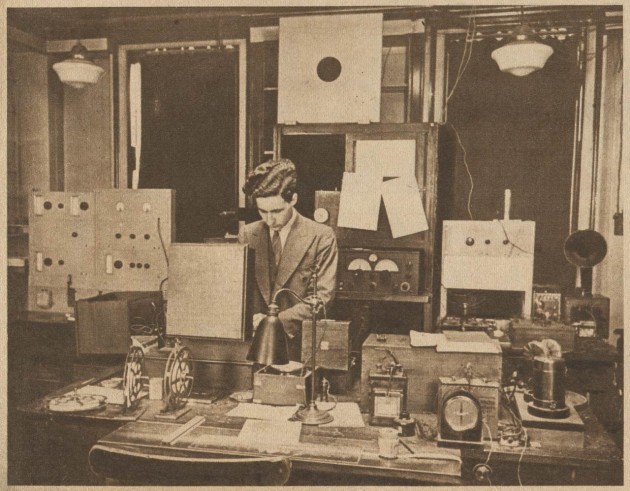
Humphry Smith in the Wireless Room c.1939. From the 24 February 1946 edition of Le Patriote Illustré
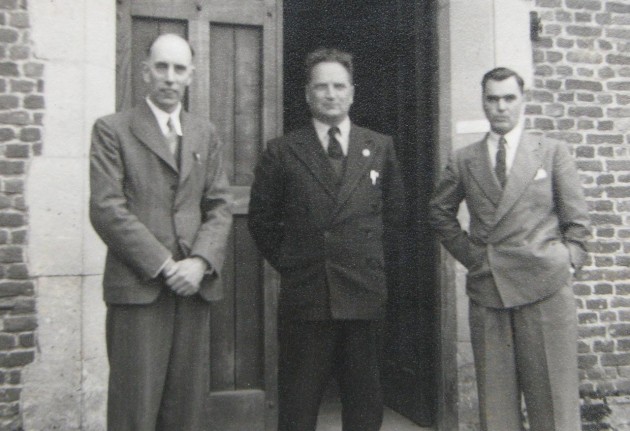
George Rickett (left), Peter Stark (centre) and Arthur Shortland (right) in front of the entrance to the Castle. The picture was probably taken in the early 1950s. Image courtesy of Hillary Buckle
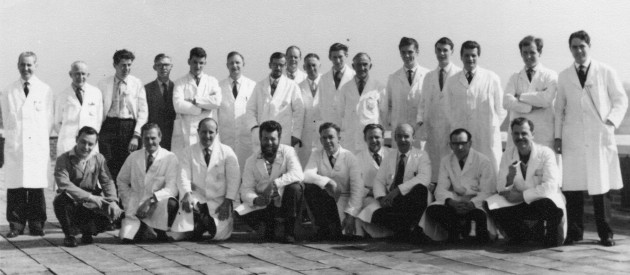
The Chronometer Section staff on the roof of the West Building in 1964. Back row (left to right): Bill Roseman, George Wilkins, Keith Jarrett, George Misson, Roy Shergold, Bert West, Chris Young, Roger Maber, John Beck, Robin Thatcher, Ron Miles, Danny Spellman, Ashley Adams, Ken Ulrick, Colin Driscol, Robin Bowie. Front row (left to right): John Barker, Alan Philcox, Cyril Taylor, Eric Mitchell, Ron Butler, John Strevett, Frank Child, Cliff Woods, Frank Heaton. Photo by Robin Bowie courtesy of Robin Thatcher
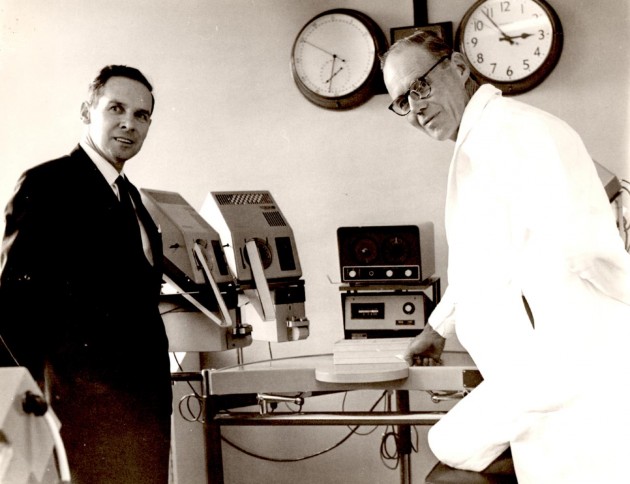
The Rating Room in the West Building in 1968. Roger Maber (PTO4) who was responsible for inspecting, rating, fault finding, quality assurance etc is on the right. Former member of staff John Bruce who worked at the Observatory in the 1940s and 1950s is on the left. They are standing in front of a bank of 4 rating machines used for testing watches. The mean time and sidereal master clocks are on the wall and were directly controlled from the Time Department elsewhere in the West Building. Image courtesy of Robin Thatcher
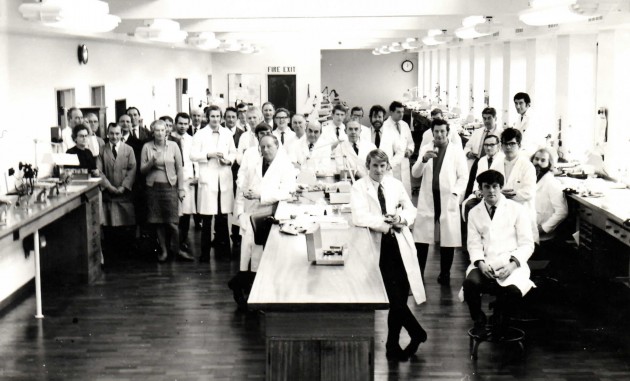
Christmas drinks in 1970 or 1971 with the 'downstairs office staff'. From left to right: 1 rear Roger Maber (PTO 4), 2 front Dorothy Clark (office), 3 rear George Misson (fitter), 4 front John Barker (fitter), 5 Mr Hazel (office), 6 Ron Maryan (office stores), 7 front Dorothy Pragnell (office), 8 ? Michael Sharp (office), 9 Graham Harper (watchmaker), 10 Bill Roseman (PTO 2 officer in charge), 11 front Chesley Richardson (watchmaker), 12 Bill Goldsmith (office stores), 13 David Seaman (watchmaker), 14 Chris Heal (watchmaker), 15 partly obscured Peter Cottingham, 16 seated front Fred Knight, 17 rear Bert West (PTO 3), 18 John Mordaunt, 19 John Beck, 20 Alan Wray, 21 Robin Thatcher, 22 Ron Butler, 23 rear partly obscured Chris Young, 24 front leaning on bench Allan Parrish, 25 bearded Eric Mitchell, 26 Roy Shergold, 27 rear partly obscured Roger Stevenson, 28 front Ken Hawkings, 29 front Laurence Hill, 30 behind Cliff Woods, 31 rear Keith Jarrett, 32 Chris Sear, 33 John Clare, 34 Frank Heaton. Photo by Ron Miles courtesy of Robin Thatcher
© 2014 – 2025 Graham Dolan
Except where indicated, all text and images are the copyright of Graham Dolan
